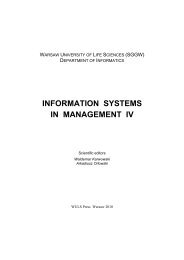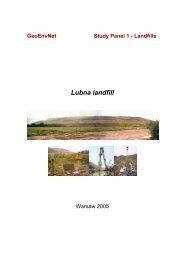ACTA SCIENTIARUM POLONORUM - SGGW
ACTA SCIENTIARUM POLONORUM - SGGW
ACTA SCIENTIARUM POLONORUM - SGGW
Create successful ePaper yourself
Turn your PDF publications into a flip-book with our unique Google optimized e-Paper software.
6 A. Gawrońska, S. Paszkowskicultural business activity. In the same time, the average monthly social security benefitsfrom the agricultural social insurance system are significantly lower than benefits fromSII. Benefits entitled from the social security insurance, both as part of the employees’,as well as agricultural insurance system, include among others: old-age pensions, pensionson account of the inability to work and survivor’s pensions [Bobola 2008, Łuczka-Bakuła, Jabłońska-Porzuczek 2008, Podstawka 2008, Wasilewski, Charemski 2006].The main purpose of the study was to determine and to compare the level of socialsecurity benefits for the agricultural and employees’ social insurance system amongprovinces of Poland in 2008. The analysis relies on the comparison of benefits paid byASIF versus Social Insurance Institution. For each of the systems the relations betweenthe number of currently paid pensions to the number of insured people has been defined.The study also identifies the level of pensions on the background of the minimal wage,average wage in 2008, as well as the average monthly available income per capita in employeesand farmers household.MATERIALS AND METHODSThe subject of the research was the level of: old-age pensions, pensions in case of inabilityto work (disability pensions) and survivor’s pensions paid as a part of the agriculturaland employees’ social insurance system. The research was conducted among provincesin Poland in 2008 (separate units at NUTS 2). The data of the Agricultural SocialInsurance Fund “Kwartalna informacja statystyczna. IV kwartał 2008 r.” and the SocialInsurance Institution “Informacja o świadczeniach pieniężnych z Funduszu UbezpieczeńSpołecznych oraz niektórych świadczeniach z ubezpieczenia społecznego”, as well as thesources of widely available domestic statistics were used.The study employed basic measures of descriptive statistics. The level of differentiationof the tested pension benefits among regions has been established with the use of thevariation coefficient (v). Moreover, the separate types of pensions have been classifiedwith using the simple grouping scheme, involving the construction of frequency distribution.As a result the considered regions were classified on the basis of the amount of paidbenefits. Such classification allows to determine the accuracy of the distribution of thebenefits among regions, as well as the comparison between the employees and the agriculturalsocial security system.In order to deepen the analysis, the indicators illustrating the number of pensions inrelation to the number of insured people, the level of types of social security benefits onthe minimum wage and average salary in 2008 (%), as well as the share of types of socialsecurity benefits in the average monthly per capita available income in employees andfarmers household in 2008 (%) were conducted.RESULTSThe average monthly number of pensions in total from employees’ social insurancesystem was 7413.7 thousand in 2008. So it was almost five times higher than the numberof such benefits paid by the Agricultural Social Insurance Fund (Table 1). Also theActa Sci. Pol.
















